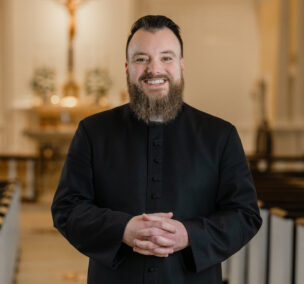Dear Brothers and Sisters in Christ,
Among the most frequently asked practical questions about the Mass is a query regarding the source of the prayers and actions used during each Mass. How do you know what to do and say? Does the priest just make it up as he goes? From this line of questioning comes an understanding of the purpose of liturgical, ordered prayer as contrasted to (not opposed to) para-liturgical or personal prayer. The simple answer is that the Church herself gives us the prayers and actions of the Mass, and the purpose of liturgical, ordered, ritual prayer is to unite those who participate in the spiritual communion of the Church spread throughout the world.
Libraries have been filled with histories of the development of liturgical norms and practices, and I will not pretend to be able to summarize that history. Suffice it to say that the practices we see in every Mass and the prayers we say rest on a vast historical foundation. It belongs to the Church’s authority to prescribe the prayers and actions used in her official ritual of worship. Thus, when a priest celebrates Mass, he is bound to use the words given to him by the Church. Mindful of this fact, the Second Vatican Council stated that no one, not even the priest, was permitted to add, remove, or change anything in the Mass on his own authority (Sacrosanctum Concilium 22). This is not out of a desire to impose a “rigid uniformity,” to use the language of Sacrosanctum Concilium, but rather to make more visible the invisible reality of our communion in faith with the Church throughout the world. Directing the priest in his offering of each Mass are rubrics, which tell him what to do, and specific texts which are proper for him to pray during the Mass. The word “rubric” comes from the Latin word for “red,” indicating the red letters. In every liturgical book, the words in red indicate what the priest is supposed to do – posture, gesture, movement in the sanctuary or around the church. The particular prayers and texts meant to be read by the priest are printed in black. An oft-repeated phrase in seminary formation as priests-to-be learn how to celebrate Mass is “Say the black, do the red.” There are certain places where the rubrics allow the celebrant to choose one text or another, or where adaptations for particular circumstances are permissible.
The spirit of the Church’s liturgy is one of unity –each individual believer is united to a greater body of believers in worship of almighty God. Thus, when we gather for Mass, we bring our individuality with the desire to be joined to the rest of the community. This is symbolized by the priest’s vestments, which cover him (as an individual) and are prescribed (both what type of vestment is to be worn and the color of the vestment) for his use, as a sign that he freely submits his individuality to the Lord, in order that, with all his personal gifts and abilities, he might help the whole assembly gathered to worship God in freedom. By following the prescriptions of the Church in celebrating the Mass, the priest shows that the Mass is not about him at all, but rather is oriented to God the Father. When the priest stands at the head of the people it is not for his own glorification, but is on behalf of the assembly in service to God. Further, when the rubrics and prescribed prayers are used correctly, the unity of the Church throughout the world is embodied in the local, particular celebration of the Mass. The unique nature of each community is welcomed and finds a home in the Church’s liturgy. There are things that make our parish community very special and distinct from other communities. Those unique characteristics do not, however, make us better than any other community. The ordered, ritual, liturgical prayer of the Church reminds us, collectively, of who we are and how we are to participate in the spiritual communion of the whole Church throughout the world.
It is important to note that the official liturgical prayer of the Church, especially the Mass, holds a legitimate place in the personal, individual spirituality of every believer. I have a personal devotion to the Mass (in addition to a vocational obligation to it!). But the Mass, properly speaking, is not “mine.” Rather, it reminds me that I am part of something greater. Therefore, it is important that I reflect on this truth in my own, personal prayer. The Church does not order or legislate my private prayer and devotional life. We are always free to say whatever we want to God, to pray as we desire. That personal, individual prayer comes with its own challenges. When we participate in the liturgical prayer of the Church, we know that we have given worship to God, that we have entered into prayer, that even when we feel we have little to offer, our participation in the communal prayer of the Church has been fruitful. A healthy spiritual life needs both the Church’s liturgy and personal prayer. Liturgy is easy, because it’s not up to us as individuals to create it, but rather is up to us as individuals to join it, the prayer that unites heaven and earth and every believer in one single chorus of praise to God.
I would like to invite you to dive deeper into the Mass, especially during the Lenten season. We will offer a special study series every Tuesday evening in Lent, using Bishop Robert Barron’s The Mass as our guide. Each session will include a video presentation from Bishop Barron, followed by discussion and Q&A, and will last approximately 90 minutes. The cost of $25 covers a workbook for each participant and gives you online access to the videos. Information about registering is available in this bulletin. I hope you’ll join us!
Peace,
Fr. Sam


